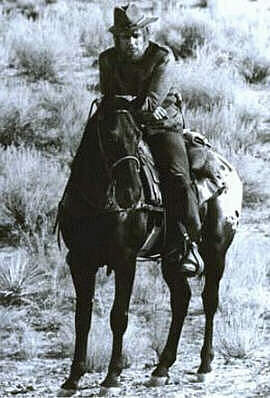

THE APPALOOSA
Marlon Brando, John Saxon
Directed by Sidney J. Furie
(Universal, 1966)
 The Appaloosa opens with Marlon Brando, bearded, scraggly haired and dirty,
looking like a cross between Grizzly Adams and the Unabomber, riding the
horse of the title into an American border town. Moments later, he is in
church saying his post confession prayers when John Saxon, sombrero on his
head and gun in hand, enters the pew to accuse Brando of having "touched"
his wife. Brando did no such thing and mumbles a denial while, unbeknownst
to Saxon, his wife is attempting to flee from her husband by riding out of
town on Brandoís horse. Her escape is prevented just in time, and rather
than let his men know that his woman had wanted to leave him, Saxon insists
she was only taking the horse for a ride before he decided whether or not to
buy it for her. Trouble is, Brandoís horse is not for sale, so, amid much
gunfire and that patently fake laughter that Hollywood always insists
Mexican bandits engage in, Saxon makes his way to Brandoís home to steal the
horse.
The Appaloosa opens with Marlon Brando, bearded, scraggly haired and dirty,
looking like a cross between Grizzly Adams and the Unabomber, riding the
horse of the title into an American border town. Moments later, he is in
church saying his post confession prayers when John Saxon, sombrero on his
head and gun in hand, enters the pew to accuse Brando of having "touched"
his wife. Brando did no such thing and mumbles a denial while, unbeknownst
to Saxon, his wife is attempting to flee from her husband by riding out of
town on Brandoís horse. Her escape is prevented just in time, and rather
than let his men know that his woman had wanted to leave him, Saxon insists
she was only taking the horse for a ride before he decided whether or not to
buy it for her. Trouble is, Brandoís horse is not for sale, so, amid much
gunfire and that patently fake laughter that Hollywood always insists
Mexican bandits engage in, Saxon makes his way to Brandoís home to steal the
horse.
"Itís not about a man stealing a horse," Brando tells his woman as he ignores her objections and prepares to head for Mexico to retrieve the animal. This western isnít about a man stealing a horse either. Rather, itís about impotence.
Brando plans to put that fine stallion to work performing stud duty so he can build a ranch for himself and his family. But bad Chuy Madina (Saxon), the leader of a gang of bandits, a man who acts like a stud but apparently canít cut it in the sack, needs that stallion to save face. "Does he ride as well as he looks," Madina asks his wife of the horse. Madina, finely attired though he may be, apparently canít ride his honey to satisfaction at all.
Even after Brando tracks Madina down and agrees to an arm wrestling match, with the winner taking the horse and the loser facing certain death from the sting of a scorpion, Madina, though victorious, doesnít really win because his scorpions are just as impotent as he is. Brando survives and, by the time the picture ends, he finishes Madina off with a long-barreled gun. Ah yes, a long-barreled gun: symbolism.
All of this thinly veiled pop psychology might be interesting if not for the artistic impotence of the people who made it. Director Sidney J. Furie made a ripple a year earlier with The Ipcress File, a spy thriller overpraised because its hero, a bespectacled Michael Caine, provided such a contrast to Sean Conneryís invincible James Bond. But Furieís career collapsed shortly thereafter with such misfires as Little Fauss and Big Halsey.
And thereís Brando midway through the long stretch between 1962ís Mutiny on the Bounty and 1972ís The Godfather when his talent appeared to have been spent and his box-office power non-existent. Why else would he be working at Universal in potboilers like The Appaloosa and The Night of the Following Day at a time when the making of feature films took a backseat to the countless hours of network television the studio was cranking out on a weekly basis? Among those TV shows were westerns like "The Virginian," "The Road West," and "Laredo," all of which showed more signs of life than The Appaloosa. Then again, considering its subject matter, it may be appropriate that The Appaloosa is so limp.
© Copyright 1999, Brian W. Fairbanks. All Rights Reserved.
Essay: On Movies and Criticism